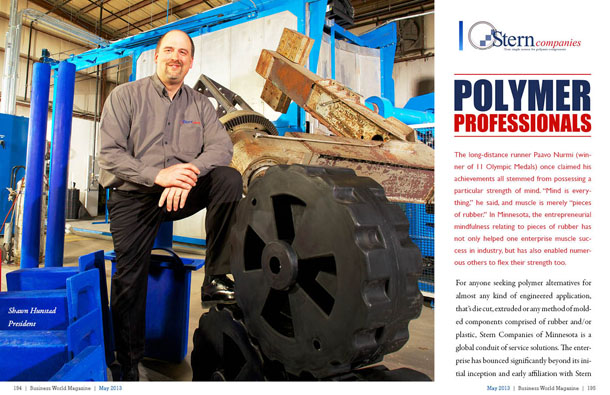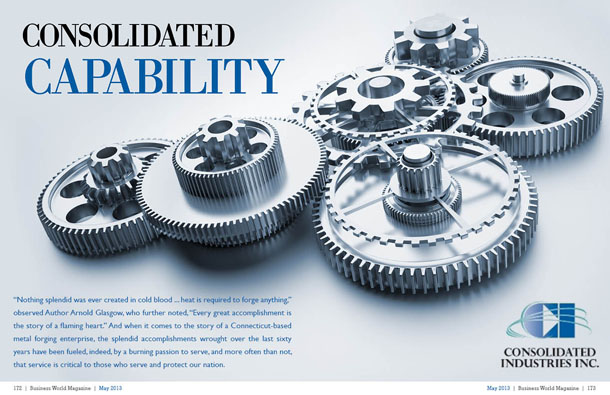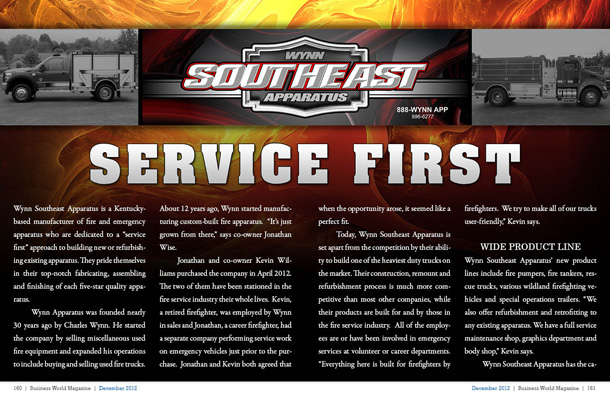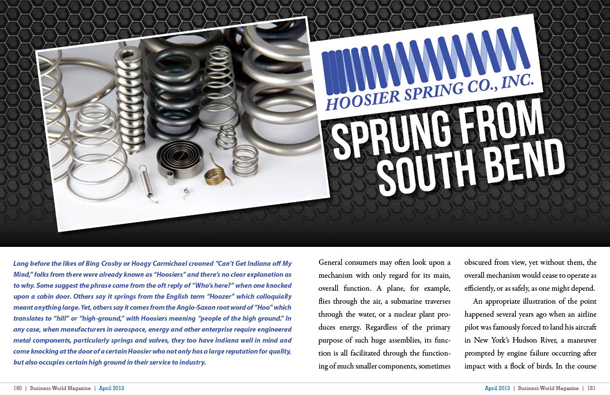
Sprung from South Bend
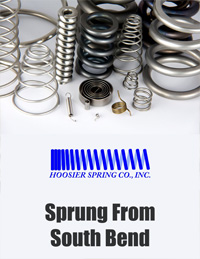
Long before the likes of Bing Crosby or Hoagy Carmichael crooned “Can’t Get Indiana off My Mind,†folks from there were already known as “Hoosiers†and there’s no clear explanation as to why. Some suggest the phrase came from the oft reply of “Who’s here?†when one knocked upon a cabin door. Others say it springs from the English term “Hoozer†which colloquially meant anything large. Yet, others say it comes from the Anglo-Saxon root word of “Hoo†which translates to “hill†or “high-ground,†with Hoosiers meaning “people of the high ground.†In any case, when manufacturers in aerospace, energy and other enterprise require engineered metal components, particularly springs and valves, they too have Indiana well in mind and come knocking at the door of a certain Hoosier who not only has a large reputation for quality, but also occupies certain high ground in their service to industry.
General consumers may often look upon a mechanism with only regard for its main, overall function. A plane, for example, flies through the air, a submarine traverses through the water, or a nuclear plant produces energy. Regardless of the primary purpose of such huge assemblies, its function is all facilitated through the functioning of much smaller components, sometimes obscured from view, yet without them, the overall mechanism would cease to operate as efficiently, or as safely, as one might depend.
An appropriate illustration of the point happened several years ago when an airline pilot was famously forced to land his aircraft in New York’s Hudson River, a maneuver prompted by engine failure occurring after impact with a flock of birds. In the course of any mechanical operation or mechanical breakdown, a number of component systems are engaged or activated which have been designed to assist in all manner of human exploit. In this instance, there were applications regulating discharge of fuel or spring components essential in landing operations and much more, but all was deployed to help mitigate what could have been a very disastrous situation. The plane landed safely with all passengers free of physical, if not emotional, injury. For his fast-thinking and focus-under-fire, Captain “Sully†Sollenberger emerged, quite deservedly, as a celebrated hero. Much further away, with no media fanfare or acclaim over the activities they undertake everyday; the workers at Hoosier Spring would later privately revel in the fact that their manufactured metallurgical components, which had been applied in that aircraft as well as countless others, functioned just as they were intended to function.
When product quality, durability and performance under pressure is not something simply depended-on, but demanded, world leaders in aviation (that’s Boeing, General Electric, Parker-Hannifin, Woodward, Pratt & Whitney, and Honeywell) rely on parts produced by Hoosier Spring. In fact, almost every aircraft in the market is complemented by a Hoosier Spring product in its landing gear or fuel control applications.
“If it flies in the sky, it probably has a Hoosier spring in it,†says Bernie Taylor, adding, their products are also found among industrial valves used in major fuel pipelines on which energy companies and consumers alike rely, or relief valves critical to commercial nuclear energy plants, and are even among the components used on carriers and submarines significant in national defense strategies.
With respect to the critical applications in which their products serve and awareness of the lives that depend on that service, Taylor says the approximately 100 comprising staff at Hoosier Spring take great pride in their work and enthusiastically attentive to the details by which their expertise is distinguished. Qualitative excellence and accountability should not, however, be construed as merely a corporate function here, it is more something of a family tradition.
Suth Succession
Based in South Bend, Indiana, Hoosier Spring sprung to life in 1954 through the hard work of Jim Suth. Prior to starting the company, Suth had worked for Bendix, a company that was ultimately absorbed by Honeywell, but in its heyday, was a dynamic, pioneering manufacturer of parts used in automobiles, aviation, appliances and electronic devices. According to Taylor, Suth toiled in Bendix’ development department where they were winding their own spring, but a time came when it was determined that it would be more efficient and cost effective to outsource that function. This inspired Suth to start his own enterprise and secure the contract with his former employer. He set-up shop in his home garage, winding springs by hand, and heat-treating it in his kitchen oven. With only six employees, Suth went on to secure new contracts, and the company coiled on to the future. Jim Suth’s son, Mike, was eventually appointed to head the company and lead it through another dynamic era of growth, and today, his son, Greg Suth, represents the third generation of family leadership.
The company has come a long way from those days of the garage. Factory operations today accommodate all manner of material resource for spring manufacturing, inspection and test. In addition to specializing in cold coiling in the forming of compression springs (whether that’s conical, cylindrical, hourglass or barrel variety), the company also produces extension springs, garter springs, clips and wire forms. Coil wire sizes can range from .008 to .540 and through their semi-automatic capability, Hoosier Spring can coil up to .750 wire. Average lot sizes figure at around 200 pieces, but the company can handle significantly larger quantities too. Hoosier Spring has expertise in the vast range of both common and more exotic metals, including stainless steels, titanium, Monel K400, Rene 41, Nispan C, Hastelloy C, oil tempered chrome vanadium, chrome silicon, and much, much more. Heat treating processes have also come a long way from the kitchen oven. Hoosier Spring, in accordance with SAE Aerospace Standard AS7003, is accredited by NADCAP, a distinction that recognizes the company’s conformance to the highest production standards involving heat treating.
Yet for all its operational and material growth, staffing and market penetration, Taylor says the operational environment of Hoosier Spring still maintains a feeling of family. He attributes part of that to longstanding customer relationships, which in some cases are 30 and 40 years long, but there are also employees who have worked for the company that long too. In fact, the company has among the best employee retention rates in the industry. In many cases, departments are led today by the sons of former department staff. Taylor says the Suth Family has always strived to instill staff with a sense that they are part of a family. “It has kept a family feel, and Mike Suth was always very big on saying, ‘This is who we are… and we treat each other this way,’ which meant being respectful, honest and cooperative. But we had to treat customers the same way too. And as we created partnerships inside the business, the approach to customers was also about creating partnerships, learning our customer needs and committing ourselves to fulfilling those needs on time with the right product and the right cost,†says Taylor.
Operational Excellence
To achieve their production quality and dependability in expeditious delivery, Taylor says the company encourages all employees to take ownership of their role in the company. They are empowered to make decisions and act on what needs to get done, or correct whatever is standing in the way of the job getting done.
Under Greg Suth’s leadership, the company determined to strengthen its quality assurance processes by going through the rigors of training involving risk management, root-cause analysis, internal auditing and Six Sigma methodology. Taylor, a Six Sigma Black Belt, says this effort not only helped Hoosier Spring achieve AS9100C Certification, but provided the tools to identify means of achieving greater efficiencies which result in even greater service and cost savings to their customers. According to one case study involving this initiative at Hoosier Spring, the improved production methods accommodated through Six Sigma helped the firm save more than 14 million operational-seconds per year (equating to annual savings of more than $313,000).
“We’re always trying to take on new business, but we also believe it is essential to maximize on the business we already have,†says Taylor. “By becoming a lean manufacture, by incorporating the principles of Six Sigma, we’ve become more efficient and can provide quicker turn around on orders without compromising on quality or increasing costs, and this has proven to be a real benefit for us and the customers we serve.â€
Taylor says self-examination, the continual process of performance auditing, is ingrained in all operational levels of Hoosier Spring. The focus on efficiency and innovation has helped them to better help their customers, a process that frequently finds Hoosier Springs advising on needed changes in material or design specifications so that customers receive a better product than what they even initially ordered. Taylor refers to such aspects as “value-added†service. And though the company is increasingly incorporating automated elements in its production model, Taylor says that has been achieved without letting jobs go. Staff may be moved into other areas, but their position isn’t terminated. “We never get rid of anybody. We find a way for them to add value someplace else. The automation allows us to better utilize our human resources so that we can, again, save customers money and make a better product in the long run. That’s what we’ve always done, and that will never stop,†affirms Taylor.
In terms of the future, Taylor anticipates Hoosier Spring to make further advances in the industries in which it is currently serving, particularly aerospace and energy. He says the company has also recently made entry into new market segments, especially in service to the military as well as to firearm manufacturers who are increasingly relying on Hoosier Spring in their product design. He also notes the company is seeing greater demand for wire forms and clips used by the automotive industry and expects Hoosier will broaden its base in that market segment soon. Otherwise, the company is advancing its heat-treating capabilities and Taylor says as more services are brought in-house, they will be able to provide faster delivery and quality to their customers. “Having the right quality at the right time, that’s what everybody wants,†observes Taylor.
He says by continually fostering an environment that focuses on respect for all, by constantly striving for excellence and efficiency, and empowering employees to take ownership of the processes that define their required performance, Hoosier Spring is poised to fully deliver on demand, and in measures that may even exceed customer expectations. This, in fact, has always been a hallmark of Hoosier Spring. As Taylor says, “Customers know what we expect from ourselves and they know we’re going to take care of them too.â€
For more information please visit their website at: Hoosier Spring Co., Inc.
Preferred Vendor of Choice:


